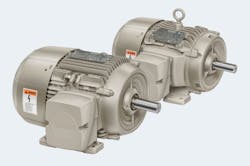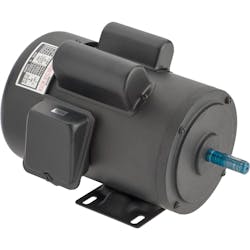While software and other advanced technologies often capture the automation technology spotlight, the fact remains that not much happens in the manufacturing or processing industries without motors. From simple applications like powering conveyors, fans, and pumps to more complex systems, motors are central to countless production operations.
And though all motors deliver similar functions, there are many different types of available. The increasing use of drives for higher level motor control and energy efficiency purposes provides another facet of consideration when selecting motors for a specific task. With so many options to consider for such a core technology, it’s no surprise that end users have a lot of questions about motor selection. One question submitted recently to Automation World was: What’s the difference between standard and inverter duty motors?
Kooiman began by explaining the different motor types commonly used in manufacturing applications. “Typically, in industry, we're focused on three-phase motors,” he said. “But there's also many single-phase motors out there. Single-phase motors use a one-phase wire and a neutral wire—this is most common for smaller motors. Three-phase motors use three different phases in the electrical systems, which are all 120 degrees out of phase with each other. This allows the motor to run much smoother and much more efficiently than a single-phase motor.”
The key difference between general purpose and inverter duty motors is that inverter duty motors are specifically built to be operated by a variable frequency drive (VFD). “A VFD allows that motor to be run at different speeds,” said Kooiman. “A typical motor starter on a general-purpose motor is only going to operate that motor at full speed.”
An important consideration when selecting between motor types is that, since the motor isn't always operating at full speed, the cooling of the motor is critical. “Most motors are cooled by a fan connected directly to the motor shaft,” said Kooiman. “So, if the fan is spinning at a slower speed than the motor, less air is moving across the motor and the motor won't cool as well. This is especially important in classified areas (e.g., Class 1, Div. 2) where the temperature of the motor needs to be kept below the ignition point of the classified area. Inverter duty rated motors often will have more cooling capacity to make sure that that motor doesn't overheat.”
Kooiman noted that VFDs have high-frequency spikes in the drive’s electrical system—caused by the switching of the transistors in the drive to adjust the motor’s speed. This is why inverter duty rated motors have thicker insulation on the motor’s windings so they can hold up to these spikes longer over time. That’s why inverter duty rated motors tend to have a longer lifetime when running on a VFD.
RPMs, duty cycles, and cost
Revolutions per minute (RPM) is, of course, a significant motor characteristic that comes into play for specific applications. Kooiman explained that RPM is “really the standard on how fast you want the motor to spin and is determined by the design of the motor itself. Both inverter duty and standard duty motors are available in many different RPM configurations. When you have a VFD, the difference is that you can operate that motor from zero to 100% of that RPM. That's really the main difference between standard and inverter duty motors when it comes to RPMs—being able to control the rate of RPMs using a VFD or running at 100% of RPMs with a standard duty motor.”
Kooiman explained that the duty cycle of a motor is about how often those motors are starting and stopping and how much of the time the motors are running. “It's often defined as the number of times per hour that the motor starts and stops,” he said. “With most applications, you're going to want a continuous duty rated motor, as that motor is often going to be running for multiple hours at a time. Both standard and inverted duty rated motors will have continuous duty ratings, whereas a duty cycle motor would be one that's only running for short periods of time.”
Given the inverter duty motor’s higher insulation and flexible design, Kooiman said these motors tend to be about 15% more expensive than a standard duty motor of similar horsepower.
Application considerations
It’s common when selecting a motor to focus primarily on the motor’s capability as well as the drive (if using an inverter duty rated motor). But Kooiman cautions to not overlook the cabling. “Using a good quality VFD cable to connect the VFD to the motor is essential to making sure that the system will perform as intended,” he said. “It really helps minimize harmonics that can leak into the rest of the electrical system and affect instrumentation and other sensitive electronics.”
Kooiman also noted that VFDs allow for a motor to be run in reverse without having to add additional hardware. And the ability to run the motor at slower speeds also helps with energy savings.
Leaders relevant to this article:




